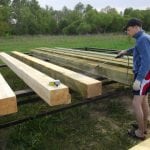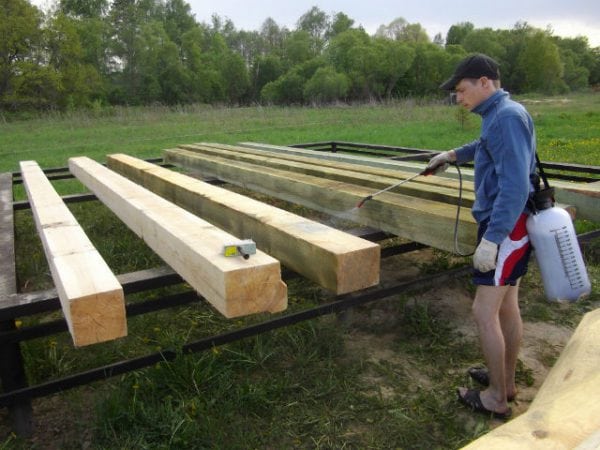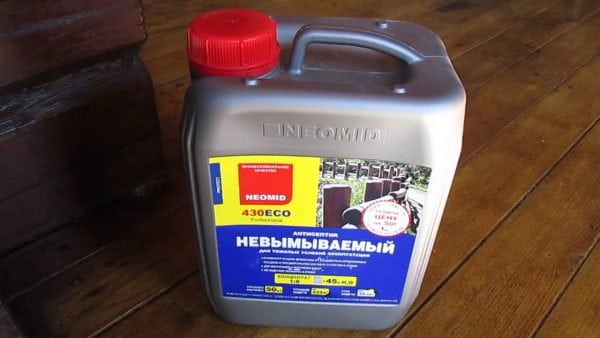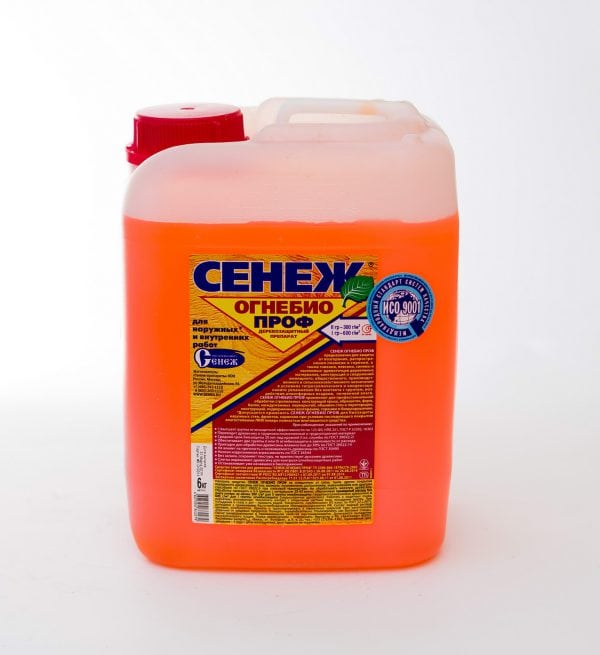The roof truss system is a wood material that is easily destroyed by contact with moisture and quickly ignites in the event of a fire. How to process the rafters to extend their service life and eliminate the formation of mold microflora. Which of the following formulations is most effective on the market? It depends on the type of wood and prevailing climatic conditions. Humid - need protection from water, hot - you need to protect the tree from fire.
- What should be the composition
- What are antiseptic agents
- Methods for applying antiseptic agents
- The most popular antiseptic agents
- The use of flame retardants
- Neomid 530 - fire protection

What should be the composition
Any tool that you decide to use to cover the rafter system must meet the following requirements:
- deeply penetrate the structure of wood fibers;
- do not contain copper sulfate, potassium dichromate, arsenic, chromium;
- it is well dissolved in water, but not washed off from a tree;
- effectively protect floor beams and crates from mold, the formation of rot, fungus, and prevent ignition.
After this, it is worth determining what is more threatening the rafter system - rot or fire. For humid climatic conditions, an antiseptic is chosen that will penetrate deep into the tree, and after that it is additionally covered with a flame retardant. The fact is that you can soak wood only once. Strengthening the properties of wood to resist the formation of rot or ignition depends on what composition is applied first.
to contents ↑What are antiseptic agents
Antiseptics for floor beams and lathing may have an additional decorative effect. The composition includes alkyd resin, which gives the tree a certain color. For the rafter system, water-soluble antiseptics are most often used. They have several advantages:
- penetrate deep into the woody structure;
- they are easy to apply to the elements of the rafter system;
- dry quickly and allow the tree to breathe;
- form a moisture-proof film on the surface of the tree.
High-quality antiseptics should have antimicrobial (biocidal) and antifungal (fungicidal) properties, as well as provide reliable protection against insects - insecticidal properties.
Water-soluble substances mainly contain sodium fluoride and silicofluoride, a mixture of borax and boric acid, pentachlorophenol, a mixture of zinc chloride with sodium (potassium) chrompeak. The compounds are toxic only to microorganisms and completely harmless to humans. There are also products that are soluble in oil, petroleum products and light solvents.
to contents ↑Methods for applying antiseptic agents
Impregnation (surface impregnation with an antiseptic) is carried out by completely immersing the wooden elements in the composition or by applying the substance with a spray / ordinary brush. For immersion use a special bathtub, a trough or even a ditch, previously lining the container with plastic wrap.
The immersion time of the material depends on the specific antiseptic. Typically, the manufacturer indicates the packaging 30-60 minutes for wood of small and medium section. When immersing large farms, for example, for roofing from natural tiles, the impregnation time is increased to four hours. After drying, all the ends of wooden structures are processed during the day.
When manually treated with an antiseptic by spraying, spraying or staining, the penetration efficiency of the composition deep into the wood is noticeably reduced. Although this method requires a small amount of antiseptic composition.
to contents ↑The coating is carried out in several layers with an application interval of about half an hour.
The most popular antiseptic agents
The Senezh modern remedy has proven itself in practice. Such an antiseptic can handle the roof, wooden crate, floor beams. The composition is presented as a ready-to-use, water-based solution. Its advantages:
- bioprotection for a period of 30-35 years;
- type of composition - difficult to wash;
- chemical bond with wood;
- deeply penetrates the structure of the fibers, without increasing hygroscopicity;
- allows the tree to breathe;
- has a decorative effect.
Recommended consumption is 250-300 g / m. cube when applied without immersion, 60-80 kg / m. cube when soaking. Senezh penetrates deep into the floor beams and other elements, forming a two-level protective barrier. Prevents the development of fungi and mold microorganisms, insects. The manufacturer produces various series of antiseptics - Ultra, Bio, Tor, Sauna for specific wooden structures.
Pinotex Impra is an Estonian-made product that is highly effective. Suitable for bioprotection of floor beams, crates, Mauerlat, rafters. It is a water-based antiseptic with an alkyd binder. It is deeply absorbed into the surface of wood, provides good protection against rot, blue, mildew.
The consumption of the substance is from 85 to 200 g per square meter, depending on the processing of wood - sawn or planed. Pinotex Impra cannot be used for elements of the rafter system already affected by microorganisms, unlike the composition of Senezh.
Means of production of Russia Drevoteks is used to protect wood material from the formation of rot, mold. Main characteristics:
- effectively protects floor beams, boards from atmospheric moisture;
- the bio series is suitable for the prevention of healthy wood material, the anti-mold series is used for the tree affected by focal microorganisms;
- type of impregnation - difficult to wash, allows the tree to "breathe";
- the term biosecurity of the rafter system with the integrated Drevotex tool is about 30 years;
- the consumption of funds is 250-350 g / sq. m when processing with a brush and 200 kg / m. cube when immersed.
The tool can be applied to new wood or as a treatment for an existing roof structure.
When choosing antiseptic compositions for floor beams, battens and mauerlat boards, it is necessary to pay attention to the moisture content of the wood, since not all antiseptics are suitable for wood with a moisture content of more than 20 percent.
to contents ↑
The use of flame retardants
Fire protection is designed to give wood material additional qualities - resistance to fire, reduction of flammability. If you decide that the probability of a fire is higher than the possibility of decay of the rafter structure, first of all all wooden fragments of the roof should be treated with flame retardants.
They are classified into the first and second efficiency groups. Means of the first group create fire protection for 5-7 years, so they are more effective. Advantageously, flame retardants include ammonium phosphates and sulfates, borax, boric acid, and combinations thereof.
All flame retardants are divided into:
- Impregnation - salt solutions that are applied manually or by immersion.
- Coating flame retardants - have a pasty consistency.
- Varnishes are used for decorative purposes. On the roof, their use is unnecessary.
- Paints form a thin protective film on the surface.
Most often, to protect the floor beams and rafters, impregnation is used when the flame retardant will serve as the main protection, and coating if the flame retardant is applied to the antiseptic. Fire retardant coating methods are identical to applying antiseptics. The market has a wide selection of compositions of the first and second categories. Neomid is very popular.
to contents ↑Since the composition received a lot of positive customer reviews, you can consider its properties in more detail.
Neomid 530 - fire protection
The product is suitable for any type of wood surface - sawn or planed floor beams, boards, rafters, lathing. Main advantages:
- fire protection for a period of ten years;
- possesses antiseptic properties;
- does not contain toxic substances and formaldehyde;
- does not interfere with further processing of wood;
- does not change the hygroscopicity of the material;
- delivered ready to use;
- made on a water basis;
- according to danger to humans, it occupies the same category as household chemicals - it is not dangerous.
Neomid formulations are available in different series. Some tools are designed to protect floor beams and other elements of the rafter system from insects, rot, blue, are used as wood bleaches. Neomid 530 is an effective fire protection, which is currently the most popular.
Before processing rafters, you must correctly select the priority of protection. The composition that is applied first will be the main one. The second substance will perform an additional protective function.






